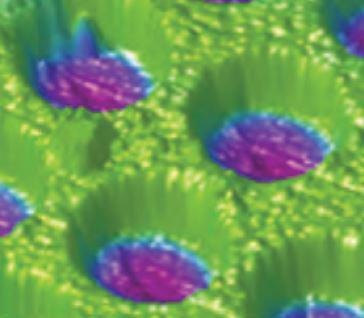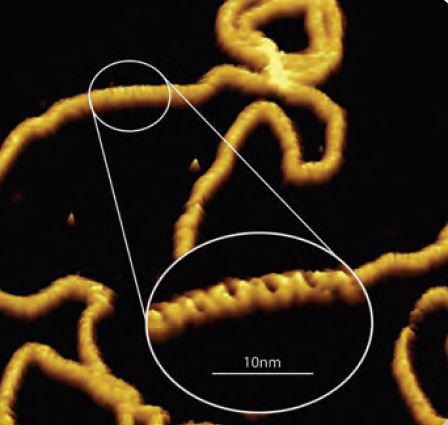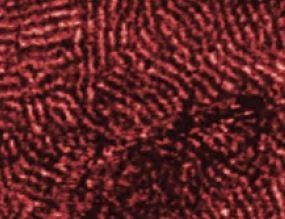Since it's inception, PeakForce Tapping has been cited by over 4000 publications; more than 1 paper per day for the last 10 years. This article will look at some of the increased capabilities this technology has enabled over this time, and discuss some of their key contributions in the fields of nanotechnology, biology, and material science.
.jpg)
PeakForce Tapping has been one of the most significant contributions to the field of atomic force microscopy (AFM) since its development by Bruker in 2009. The release of this method directly followed the success of Bruker’s previous TappingMode technique and is one of the most rapidly adopted AFM techniques of all time.
The basic operating principle of PeakForce Tapping is the regular tapping of a probe on the sample, with deflection of the cantilever directly measuring the pN-level interaction force. By incorporating a real feedback loop, the peak force is restricted to 10 pN at actuation rates up to 8 kHz, both in air and fluid.
It is this incredibly low force and simplicity in use that has been the key to the widespread uptake of PeakForce as an AFM technique. By removing the need to calibrate the cantilever, the bar to operation is lowered, and the low peak force allows the mapping of structures as small as atomic defects and DNA double helices.
Being able to analyze materials from the softest biological samples to hard silicon-based collar cells at the atomic scale is an attractive proposition to a huge number of disciplines. The following are just a few of the innovative examples of the use of PeakForce Tapping, but there have been many more over the years.
PeakForce-KPFM
PeakForce-KPFM is a combination of Kelvin Probe Force Microscopy and PeakForce Tapping. By combining these complementary techniques, previous issues such as measurement precision and low spatial resolution can be overcome.
The resulting model can be used to investigate areas that weren’t accessible before, including photovoltaic effects on solar cells, and corrosion and surface analysis of alloys.
Quantitative Work Function Measurements with PeakForce-KPFM
Electrochemical Analysis
 Scanning electrochemical microscopy (SECM) is the most popular method for the investigation of electrochemistry at the micro and nano-scales. When Bruker developed PeakForce Tapping, it was the perfect time to combine the two and achieve sub-micron resolution with comparative ease.
Scanning electrochemical microscopy (SECM) is the most popular method for the investigation of electrochemistry at the micro and nano-scales. When Bruker developed PeakForce Tapping, it was the perfect time to combine the two and achieve sub-micron resolution with comparative ease.
To facilitate consistent capability, Bruker developed a 50 nm nanoelectrode probe tip. This allows the simultaneous measurement of electrical, topographical, and quantitative properties in air as well as liquid, without the need to tune the cantilever. PeakForce SECM is ideal for the investigation of complex battery systems, which often include liquid electrolytes.
An Introduction to AFM-Based Scanning Electrochemical Microscopy
PeakForce Tapping in the Life Sciences
 Peak force atomic force microscopy data has also been extensively used for studying biomolecules. Instead of a linear ramping, the tip-sample distance is instead modulated in a sinusoidal motion so that by the time it makes contact with the sample the tip velocity is zero.
Peak force atomic force microscopy data has also been extensively used for studying biomolecules. Instead of a linear ramping, the tip-sample distance is instead modulated in a sinusoidal motion so that by the time it makes contact with the sample the tip velocity is zero.
This constant feedback loop allows continual adjustment of the relative tip-sample position, protecting both the sample and tip from damage. This is highly useful when studying delicate biomolecular samples, such as the loosely bound helical structures of DNA.
Using PeakForce Tapping to Image the DNA Double Helix
Mechanical Characterization at the Nanoscale
The high precision of PeakForce Tapping makes it the perfect companion to a variety of other experimental methods. PeakForce QNM (quantitative nanoscale mechanical) characterization is a technique that can map material properties at the nanoscale, including deformation, dissipation, adhesion, and modulus, while imaging sample topography at atomic-scale resolution.
High-Resolution Imaging and Nanoscale Property Mapping using PeakForce Tapping AFM
Semiconductor Analysis
 PeakForce TUNA is ideal for studying conductive but fragile samples, such as nanoparticles, conductive nanotubes, and organic photovoltaics.
PeakForce TUNA is ideal for studying conductive but fragile samples, such as nanoparticles, conductive nanotubes, and organic photovoltaics.
With highly precise force control and the elimination of lateral forces, high-resolution current imaging and sensitivity are possible.

 Download: The PeakForce Tapping Celebratory Guide
Download: The PeakForce Tapping Celebratory Guide
Looking to the Future
The above is just a short description of what can, and has, been achieved in just 10 years using the PeakForce Tapping mode system. With the continued effort and trust in the technique by researchers the world over, think what could be possible in the next decade.
If you’d like to know more about PeakForce Tapping or would like to read in more detail about some of the concepts and processes described in this article, please see the suggested further reading below:
.jpg)
This information has been sourced, reviewed and adapted from materials provided by Bruker Nano Surfaces. For more information on this source, please visit Bruker Nano Surfaces.